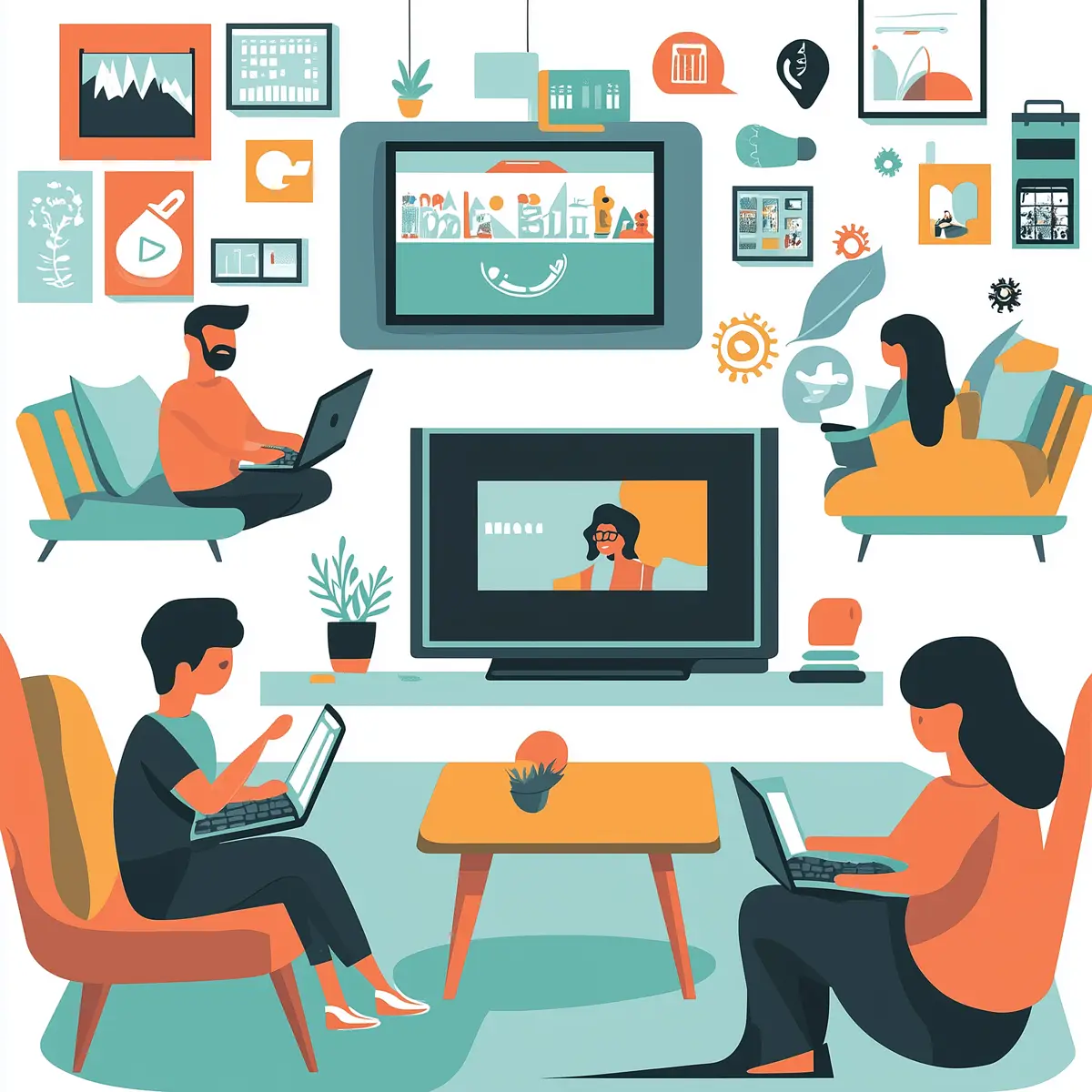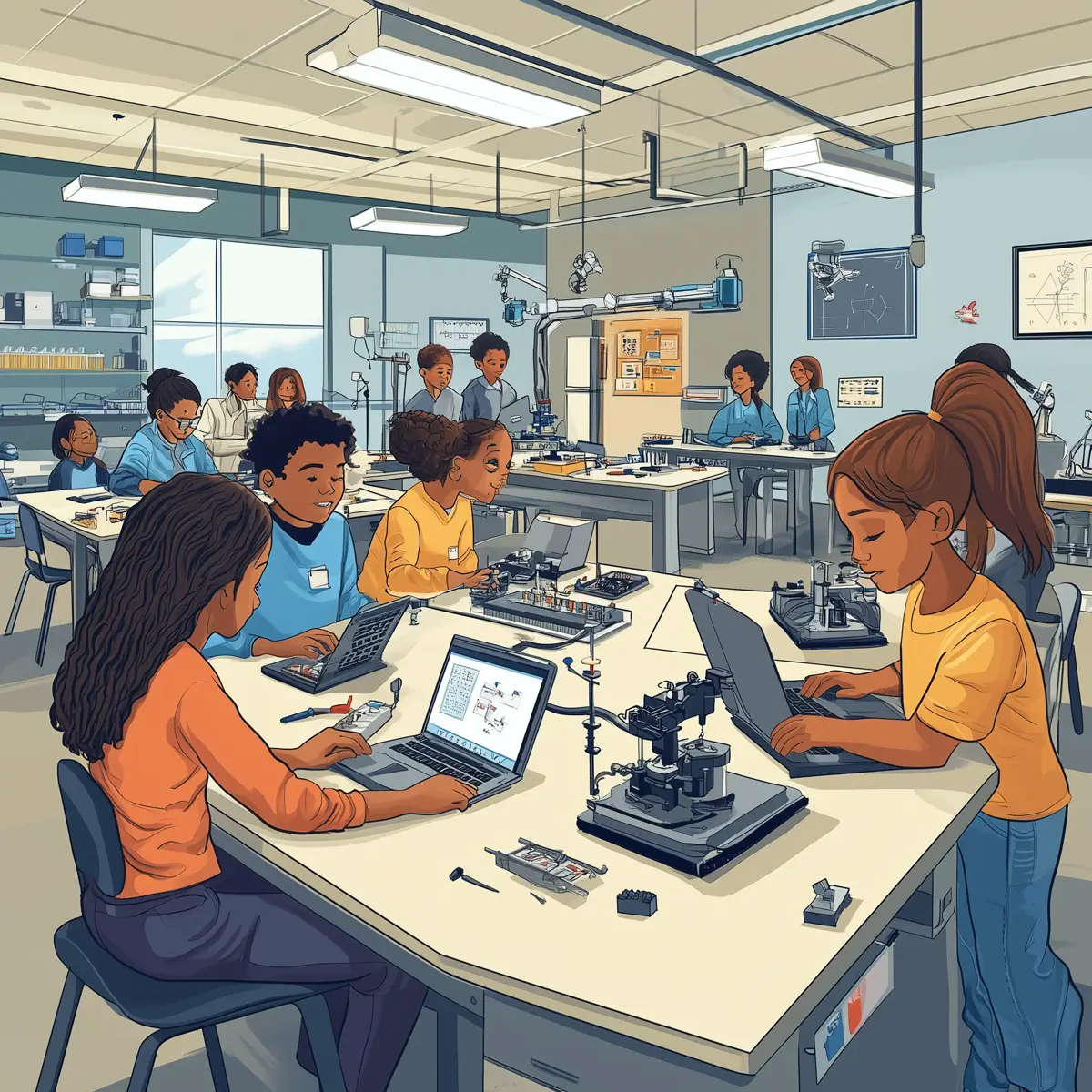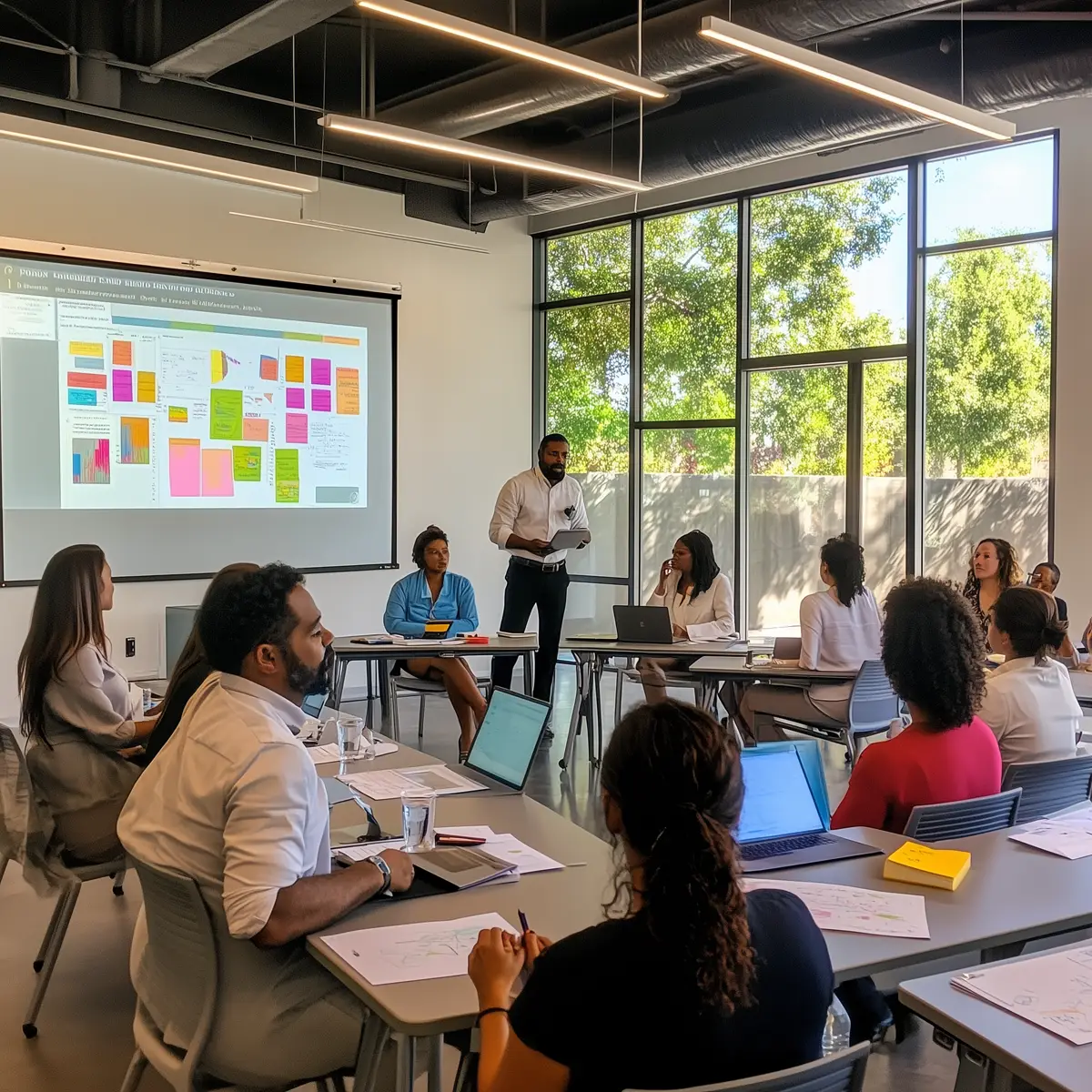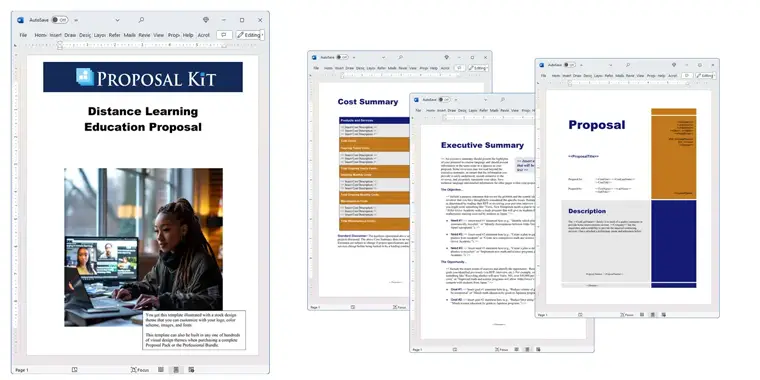How to write your Distance Learning Education Proposal
We include this 24 page layout with every Proposal Pack. If you want this template to have a different visual design theme than the one illustrated here, purchase any Proposal Pack design and create this template using the purchased design theme. This template is included in every Proposal Pack. If you get a Proposal Pack or the Professional Bundle, you can also make any variation of this template with different chapters to suit your needs.
We typically include more chapters in the templates than most people will need to give everyone more variety in the chapters they may need. You can trim down a long template by removing pages you do not need or combining multiple chapter topics into one page.
 DOWNLOADABLE, ONE-TIME COST, NO SUBSCRIPTION FEES
DOWNLOADABLE, ONE-TIME COST, NO SUBSCRIPTION FEES If you need this template on DVD media order from our Amazon shop.
If you need this template on DVD media order from our Amazon shop.
You can also create countless variations of this document to suit your needs using the included library of 2200+ chapters if ordering a Proposal Pack or Pro Bundle.
 What Our Clients Say
What Our Clients SayI’ve been designing web sites and templates for some time now, and thought that this was just a natural fit to add to my product line due to the quality of "packs" and the type of service and support that Proposal Kit provides. Add these packs to your design arsenal to add that extra fine "touch" to your proposals. A perfect addition to the proposal kit as well which is "a must" for the serious web developer."
Creative Director
Web Blends, LTD.
Related Article
Related Video
Related Templates
- Non-Profit Parenting Distance Learning and Workshop Proposal
- STEM Educational Program Proposal
- Vocational Education Proposal
- Training Services Proposal
- Tutoring Educational Services Proposal
- School Funding Request Proposal
- Online School and Media Outlet Funding Proposal
- Computer Lab for Students Educational Proposal
- Educational Training for Special Needs Proposal
- Mobile Literacy Program Funding Proposal
- Womens Center Funding Proposal
- Homeless Womens Shelter Non Profit Funding Proposal
- Life Skills Tutoring Services Proposal
- Mobile Classroom Sales and Rental Proposal
- Training Plan
- Training Program Curriculum Innovation Proposal
- New College Curriculum Proposal
- Outreach Center Funding Proposal
- Non profit Support Proposal
- Retraining Workers Skills Development Proposal
- Specialized Training Educational Proposal
- Training for Skills Development Proposal
- Vocational Job Training for Youth Proposal
- Non Profit Parenting Distance Learning and Workshop Proposal
- Moving Training Services Online Proposal
- Corporate Training Services Proposal Template
- DOE Federal Government Grant Proposal
- Business Coaching Proposal Template
- School Improvement Project Proposal
- Sales Training Proposal Template
- DOE Federal Government Grant Proposal 2
What's the Best Way to Write Your Distance Learning Education Proposal?
The demand for quality distance learning options has surged, presenting opportunities and challenges for educators and organizations aiming to provide these vital services. A compelling distance learning education proposal is crucial for securing the support and resources necessary to bring these educational opportunities to life. What is the most effective solution to this complex challenge? Utilizing a Proposal Kit template and software package.
Are you tasked with creating a proposal for distance learning services? The journey from recognizing this need to finding a solution is crucial, and the Proposal Kit is here to guide you every step of the way.
What Types of Projects Are Distance Learning Education Proposals Written For?
Distance learning education projects can vary widely in scope and audience, but all share the goal of making education accessible to those who cannot attend in person. Examples of such projects include:
- Virtual classrooms for K-12 students
- Online professional development courses
- Digital literacy programs for adults
- E-learning platforms for college courses
- Remote training modules for emergency responders
- Virtual tutoring services for underserved communities
- Online language learning programs
- Web-based STEM workshops for young learners
- Distance education for special needs students
- Continuing education courses for professionals
Chapters this template is built with
Proposal Kit's vast library of templates provides a structured approach to proposal writing, ensuring that every crucial aspect of your distance learning project is covered. Here's how various templates from the Proposal Kit can be used to build your proposal.
By elaborating on these sections with depth and clarity, your distance learning education proposal will stand out as a well-conceived, compelling argument for the support your project deserves. Proposal Kit provides the structure and resources to articulate your vision effectively, transforming the potential of distance learning into a tangible, impactful reality.
This list is just a glimpse of the thousands of templates available in Proposal Kit's template library, which can be customized to cover all topics your proposal needs to discuss. Writing the proposal is just one task in setting up the overall project. Each template is a Word format document you can edit and save as a PDF file for delivery, offering a flexible and professional way to present your distance learning education proposal.
Cover Letter
The cover letter is more than just an introduction; the handshake precedes your proposal. It sets the stage, offering a glimpse into your organization's passion for education and commitment to extending learning opportunities beyond traditional classroom boundaries. Here, you briefly state the purpose of your proposal, emphasizing the unique benefits your distance learning project will bring to potential funders or partners.
Executive Summary
Consider the executive summary of your proposal's elevator pitch. It condenses your proposal into a digestible format, highlighting the critical need for distance learning services in educational settings. This section should paint a clear picture of the project's goals, the population it serves, and the tangible impact it aims to achieve, compelling the reader to delve deeper into the details of your proposal.
Needs Assessment
A well-researched needs assessment forms the backbone of your proposal. You demonstrate a deep understanding of the educational gaps your project aims to fill by presenting data and analysis. This section should detail the demand for distance learning solutions, backed by statistics, studies, and testimonials, showcasing how your project is not just a nice-to-have but a necessity.
Accessibility
Accessibility is paramount in distance learning. This section outlines your strategies to ensure that all learners, regardless of physical or learning disabilities, can access and benefit from your programs. Discuss the technologies and methodologies you will employ to create an inclusive learning environment that respects and accommodates diversity.
Virtualization
Virtualization is the heart of distance learning. You describe the digital platforms and technologies hosting your educational content here. Whether leveraging existing educational technologies or developing bespoke solutions, this section should reassure readers that your approach is technologically sound and practical.
Outreach
Your outreach strategy demonstrates how you will attract and retain learners. Detail your marketing tactics, partnerships with community organizations, and any other channels you will use to engage your target audience. This section is where you show your project's visibility and viability, ensuring it reaches those who stand to benefit most.
Format
The format of your distance learning program is critical to its success. Explain whether you'll use synchronous (live) sessions, asynchronous (pre-recorded) content, or a hybrid approach and why. This section should convey how your instructional design maximizes learning outcomes and accommodates your students' diverse needs and schedules.
Project Background
Provide a narrative of your organization's journey and any previous engagements in distance learning or related initiatives. Success stories and lessons learned illustrate your capacity to manage and deliver on the proposed project, enhancing your proposal's credibility.
Attendance
Detail your mechanisms for monitoring attendance and participation, which are crucial metrics for any educational program. Discuss how you will encourage consistent engagement with the course material through interactive elements, mandatory assignments, or other motivational strategies.
Workshops
If your distance learning program includes workshops, describe their content, objectives, and how they complement the primary curriculum. Workshops offer a chance for deeper engagement and should be framed as an added value to the overall learning experience.
Curriculum
The curriculum is the academic core of your proposal. Outline the courses offered, the curriculum development process, and how it aligns with learners' needs. This section should highlight your program's educational rigor and relevance, assuring stakeholders of its quality.
Equipment
List the technological requirements for instructors and students, addressing how access to necessary equipment will be ensured. Whether through loan programs, partnerships, or direct provision, this section addresses a fundamental aspect of distance learning accessibility.
Community
Building a sense of community is crucial for distance learning environments. Explain how your program will foster interaction among students and between students and instructors, using forums, group projects, and other collaborative tools to create a supportive learning network.
Sources of Funds
Identify your project's potential funding sources, demonstrating your proactive approach to securing the financial backing necessary for its success. This section should list grants, sponsorships, donations, and any other revenue streams being pursued.
Uses of Funds
Transparency in allocating funds reassures funders of your project's financial integrity. Provide a detailed account of your budgeting, showing how each dollar contributes to the project's educational goals.
Funding Request
Here, you articulate your financial needs directly, specifying the funding required and its impact on the project's success. This request should be compelling, data-backed, and connected to the outcomes you aim to achieve.
Budget
The budget section offers a detailed financial blueprint of your project, itemizing expenses, and anticipated income. Using Proposal Kit's line item quoting database system ensures precision, lending your proposal further credibility.
Company History
Share your organization's story, highlighting its achievements and contributions to the educational sector. This history builds trust with potential funders or partners, showcasing your track record of success and commitment to education.
Education
This section underscores your organization's expertise and experience in delivering educational programs, particularly distance learning. Highlighting your educational philosophy, methodologies, and achievements positions your proposal as the work of seasoned professionals.
Programs and Activities
Detail the range of programs and activities your distance learning project will encompass, showing how each component fits into the larger educational objective. This comprehensive overview should illustrate the project's depth and breadth, emphasizing its value to learners.
Faculty
Introduce the educators and staff who will bring your distance learning project to life. Their qualifications, experience, and passion for distance education humanize your proposal and affirm the quality of instruction participants will receive.
Use cases for this template
Mia's Educational Leap Expanded
Mia's journey began with the realization that the education landscape was rapidly evolving. As the owner of Future Minds Academy, she recognized the growing demand for flexible, accessible learning options. However, venturing into distance learning was uncharted territory for her small business. The challenge was technological and pedagogical-translating the personalized, interactive learning experiences her academy was known for into a virtual environment.
Turning to the Proposal Kit was a strategic move. The templates provided a clear framework, guiding Mia through each section of her proposal, from outlining the educational philosophy underpinning her approach to virtual learning to specifying the technology platforms used and even addressing concerns about student engagement and assessment in an online setting. The financial templates allowed her to create a transparent, detailed budget that clearly outlined the cost-effectiveness of her approach compared to traditional learning models.
The success of Mia's proposal lay not only in its comprehensive nature but also in how it communicated her vision. It wasn't just about adopting distance learning but expanding educational access while maintaining the quality and ethos that Future Minds Academy was known for. Winning the contract validated her vision and a testament to the academy's adaptability and commitment to educational excellence.
Liam's Deadline Dash Expanded
Liam's challenge was the kind that keeps professionals awake at night-a high-stakes proposal due in an impossibly short timeframe. TechEd Innovators, his employer, had the opportunity to expand its reach through a distance learning program significantly, but the proposal deadline was looming large. Traditional proposal writing methods, with their iterative drafts and lengthy review processes, were out of the question.
The decision to use the Proposal Kit and an AI writing tool was born out of necessity but was a game-changer. Proposal Kit's structured templates acted as a roadmap, ensuring that Liam didn't overlook any critical components of the proposal, from the executive summary to the detailed project plan. Meanwhile, the AI tool, fed with strategic prompts by Liam, generated initial drafts for various sections, which he then refined and aligned with the proposal's overall tone and objectives.
The combination of Proposal Kit's organization and the AI tool's speed allowed Liam to produce a thorough and persuasive document. The proposal showcased TechEd Innovators' innovative approach to distance learning, emphasizing their commitment to leveraging technology for educational excellence. Meeting the deadline was an achievement, but the real triumph was the proposal's reception-TechEd Innovators was chosen to lead the project, a significant win for the company and a personal victory for Liam.
Nora's Global Vision Expanded
Nora's task was daunting: to draft an RFP that would attract the best distance learning providers for a project with a global scope. The Worldwide Education Fund aimed to make quality education accessible in several countries with unique challenges and needs. The RFP needed to be comprehensive, specifying the fund's goals and requirements while being flexible enough to accommodate diverse educational contexts.
Using the Proposal Kit, Nora could structure the RFP in a detailed and precise way. She outlined the non-profit's vision for global education access, specifying the criteria for potential providers, including technological capabilities, curriculum flexibility, and cultural sensitivity. The templates helped Nora articulate complex requirements in a way that is accessible to a broad audience of potential providers.
The clarity and thoroughness of the RFP paid off. Proposals came in from innovative educational providers, each offering unique solutions for the challenges of global distance learning. The process of selecting a partner was rigorous, but ultimately, the Worldwide Education Fund partnered with a provider whose vision for international education aligned closely with their own. This partnership marked the beginning of an ambitious project to transform education access across continents, a testament to Nora's careful planning and the comprehensive RFP facilitated by Proposal Kit.
Conclusions and Recommendations
Proposal Kit played a pivotal role in overcoming the challenges of writing a distance learning education proposal. By providing a structured, comprehensive, and customizable toolkit, Proposal Kit enables educators, businesses, and non-profits to articulate their vision, meet critical deadlines, and secure the partnerships and funding necessary to make distance learning a reality.
Also Known As
This template may also be referred to in different ways or be used in more specialized situations, such as:
- Remote Learning Program Proposal
- Virtual Education Initiative Plan
- Online Learning Strategy Proposal
- E-Learning Development Proposal
- Distance Education Program Blueprint
- Web-Based Learning Strategy Document
- Remote Education Implementation Plan
- Virtual Classroom Proposal
- Internet-Based Education Framework
- Digital Learning Project Proposal
Abstract
 For higher education, the demand for accessible distance learning has surged, necessitating well-written distance education proposals. These proposals are critical in securing support, aligning with regulations, and obtaining financial aid, particularly through mechanisms like the State Authorization Reciprocity Agreement. This framework facilitates compliance across member states, ensuring institutions protect students and maintain accountability. Key topics in writing a proposal include needs assessment, curriculum design, technology integration, and budgeting for Title IV funds. Federal TRIO programs can enhance educational access further, while proposals must address clock-hour programs and accreditation standards to maintain governance and quality.
For higher education, the demand for accessible distance learning has surged, necessitating well-written distance education proposals. These proposals are critical in securing support, aligning with regulations, and obtaining financial aid, particularly through mechanisms like the State Authorization Reciprocity Agreement. This framework facilitates compliance across member states, ensuring institutions protect students and maintain accountability. Key topics in writing a proposal include needs assessment, curriculum design, technology integration, and budgeting for Title IV funds. Federal TRIO programs can enhance educational access further, while proposals must address clock-hour programs and accreditation standards to maintain governance and quality.
Distance education proposals are tailored to diverse projects such as virtual classrooms, digital literacy programs, and remote training modules, each designed to foster educational access beyond traditional settings. The Proposal Kit serves as a comprehensive tool, guiding users through the creation of compelling proposals. These proposals articulate the vision, objectives, and strategies to potential funders or partners, emphasizing financial integrity and the tangible impact on learning communities.
Institutions like universities and other educational entities must adapt to proposed changes in regulations, ensuring alignment with state authorization and reciprocity agreements. Discussions about additional information and issue papers underline the importance of understanding compliance rules and maintaining accreditation. The executive director's role is in steering these efforts, navigating the complexities of higher ed regulations.
 As distance learning initiatives expand, schools must determine effective communication strategies and outreach efforts to engage and retain students. This involves using innovative technologies and creating inclusive learning environments. The semester structure, along with synchronous and asynchronous formats, should cater to varied learning styles and schedules. Moreover, fostering a sense of community remains vital, with interactions facilitated through collaborative platforms.
As distance learning initiatives expand, schools must determine effective communication strategies and outreach efforts to engage and retain students. This involves using innovative technologies and creating inclusive learning environments. The semester structure, along with synchronous and asynchronous formats, should cater to varied learning styles and schedules. Moreover, fostering a sense of community remains vital, with interactions facilitated through collaborative platforms.
The success of a distance learning proposal hinges on presenting a clear project background, detailing attendance tracking, and outlining the required equipment for participants. Transparency in the use of funds and a well-defined funding request are crucial in building trust with stakeholders. Ultimately, a robust distance education proposal not only secures necessary resources but also aligns with the broader mission of extending educational opportunities, making hope a driving force for transformation in the higher education landscape.
Distance education initiatives are reshaping the higher education landscape, driven by the need for flexible learning solutions that cater to diverse audiences. The creation of a robust distance learning education proposal is paramount in navigating the complexities of state authorization and ensuring reciprocity agreements with member states. These proposals must align with existing regulations to safeguard Title IV funds and comply with federal TRIO program guidelines, thus protecting students and enhancing financial aid opportunities.
 The Proposal Kit offers a structured methodology to build comprehensive proposals that address the nuances of various projects, from online language learning programs to continuing education courses for professionals. By using this toolkit, executive directors and educational institutions can articulate their vision, detailing how clock hour programs will be implemented to maintain educational rigor and accountability.
The Proposal Kit offers a structured methodology to build comprehensive proposals that address the nuances of various projects, from online language learning programs to continuing education courses for professionals. By using this toolkit, executive directors and educational institutions can articulate their vision, detailing how clock hour programs will be implemented to maintain educational rigor and accountability.
A critical part of these proposals is the needs assessment, which relies on data-driven insights to highlight educational gaps and justify the necessity of the project. This analysis is supported by issue papers and discussion documents that provide additional information on proposed changes within the education sector. Discussions around compliance and accreditation ensure that programs not only meet regulatory standards but also foster innovation in higher ed.
The engagement strategies outlined in these proposals underscore the importance of outreach and marketing efforts, which are vital for enrolling students and maintaining course participation throughout the semester. Institutions must determine effective communication channels to reach their target audiences, including military personnel and underserved communities, offering them opportunities to complete their education in an inclusive environment.
 Furthermore, the integration of technology in distance education is critical. The proposal must detail the virtualization of learning environments, ensuring robust and scalable solutions that support both synchronous and asynchronous formats. This includes discussions around cybersecurity, data privacy, and the technical support needed to create an accessible digital classroom.
Furthermore, the integration of technology in distance education is critical. The proposal must detail the virtualization of learning environments, ensuring robust and scalable solutions that support both synchronous and asynchronous formats. This includes discussions around cybersecurity, data privacy, and the technical support needed to create an accessible digital classroom.
The governance structures and entities involved in managing the program are crucial for its success. Proposals should delineate executive roles and responsibilities, emphasizing the power of collaborative leadership in achieving the institution's educational objectives. Additionally, faculty qualifications and the educational philosophy guiding the curriculum are highlighted to assure stakeholders of the program's quality.
Ultimately, a well-written distance education proposal not only seeks financial backing but also positions the educational institution as a leader in providing innovative learning solutions. By addressing every facet of program implementation-from budgeting and funding requests to community building and student engagement-these proposals serve as a blueprint for transforming educational access and achieving long-term goals in the landscape of higher education.
Frequently Asked Questions
What should I include in a distance learning education proposal?
A comprehensive distance learning education proposal should include several key components: a clear executive summary, a detailed description of the program objectives and goals, a thorough needs assessment, a well-structured curriculum plan, technology and platform requirements, faculty and staff roles and responsibilities, budget and funding sources, an implementation timeline, and an evaluation and assessment plan. Each section should be detailed to ensure the proposal is persuasive and actionable.
How do I assess the needs for a distance learning program?
Conducting a needs assessment involves gathering and analyzing data to understand the demand and requirements for the proposed program. This can include surveys and interviews with potential students, faculty, and stakeholders, reviewing current educational trends and gaps, and analyzing demographic and market data. The goal is to identify who the program will serve, what their specific needs and preferences are, and how the program will address these needs effectively.
What technology considerations should be included in the proposal?
Technology is integral to distance learning, so your proposal should detail the necessary software and hardware, including learning management systems (LMS), communication tools, content creation tools, and student information systems. Additionally, it addresses the technical support and training required for both instructors and students and considerations for accessibility, cybersecurity, and data privacy. Ensuring the technology infrastructure is robust and scalable is essential for the program's success.
How do I create a realistic budget for the distance learning program?
Developing a realistic budget involves outlining all expected costs associated with the program, including technology and software, instructional materials, faculty and staff salaries, marketing and recruitment, and ongoing maintenance and support. It's essential to provide detailed justifications for each expense and explore various funding sources, such as grants, partnerships, and tuition fees. Clearly demonstrating a well-thought-out financial plan will help secure approval and support for the proposal.
What methods can be used to evaluate the effectiveness of the distance learning program?
To evaluate the effectiveness of the distance learning program, your proposal should include a robust assessment plan with both formative and summative evaluation methods. This can involve regular feedback from students and faculty, monitoring student engagement and performance metrics, conducting surveys and focus groups, and comparing learning outcomes against set benchmarks. Continuous improvement should be emphasized, with mechanisms in place to adjust the program based on the evaluation results to ensure it remains effective and relevant.
15% Off Discount
![]() Add To Cart This Word Template Only
Add To Cart This Word Template Only
 Add To Cart Proposal Pack for Any Business
Add To Cart Proposal Pack for Any Business
 Add To Cart Proposal Kit Professional Bundle
Add To Cart Proposal Kit Professional Bundle
 4.7 stars, based on 846 reviews
4.7 stars, based on 846 reviewsProposal Kit chapters used in this template
Cover Letter, Title Page, Table of Contents, Executive Summary, Needs Assessment, Project Background, Education, Accessibility, Workshops, Programs and Activities, Curriculum, Faculty, Equipment, Virtualization, Format, Attendance, Community, Outreach, Sources of Funds, Uses of Funds, Funding Request, Budget, Company History, Back Page
Included Calculator Spreadheets
These Excel calculator spreadsheets are included with this template. If you purchase a Proposal Pack or the Professional Bundle, these proposal pages are generated using an automated line-item database in the included Wizard software. The calculator spreadsheets are intended for use when purchasing only the static Word template.
You use this proposal for
- General business proposal
- Education, training proposal
- Non-technical proposal
- Project pitch proposal
- Non-government grant, non-profit, NGO proposal
- Spiritual, church, community proposal
How to create this template with Proposal Pack Wizard
You can create this document using any of the logo-designed Proposal Packs. Pick any Proposal Pack with a logo design theme you like best; they will all work equally well. The Proposal Pack for Any Business is the pack with no extra added logos or colors - designed to be used plain or for you to customize with your logos and graphics.
The Proposal Pack design theme you purchase will determine the visual look of this template. The screenshot above only shows the plain generic design theme. Names and stories in examples are fictional; however, the templates are from real client use cases.
We include a library of chapters to be assembled based on your needs. All proposals are different and have different needs and goals. We designed Proposal Pack so you can customize the documents to suit your needs.
You will best create this document using the Proposal Pack Wizard - Expert Edition software to select this template and build it in the Proposal Pack logo design theme of your choice along with any desired customizations (such as adding additional chapters, removing unneeded chapters, changing the order of chapters, and importing your company logo). This template outlines a proposal for the described situation. Each user is responsible for typing in the actual content of the provided pages with their information to complete the proposal. Suggestions in the abstract may include features in higher-end packages and are facilitated by the selection of chapter templates to support the narrative of each proposal, which help guide the user in filling in the details.
You create this template using the Wizard software with an entire Proposal Pack library and software. We include the Expert Edition of the software in the Proposal Kit Professional bundle. Microsoft Word for Windows is required to use the customizing software. You can also edit Word document templates in other office software such as Word for Mac. We will assist Mac users in assembling complex templates for their first project if they do not have the required platform to run the Wizard software.
You only get the single assembled Word document if purchased as a stand-alone template. The individual template products include no other templates, samples, or software.
How to Build Templates Featured on Proposal Kit Website
Many people find the Proposal Kit website after searching for a specific proposal. Once you've purchased and installed the software, how do you build that template you found in the first place? This video shows you how to build any proposal you see on the Proposal Kit website.
Key Takeaways
- The Distance Learning Education Proposal is available as a ready-to-edit template.
- You can create unlimited custom variations of this template using a Proposal Pack or the Professional Bundle.
- Using a Proposal Pack or Professional Bundle, you can automate quotes and other financial pages with a line-item database.
- There are no ongoing subscription fees. You get lifetime unlimited use.
- We made Proposal Kit for freelancers, small businesses, and non-profits.
- Proposal Kit product content (templates, samples, software) is 100% written by humans.
 Ian Lauder has been helping businesses write their proposals and contracts for two decades. Ian is the owner and founder of Proposal Kit, one of the original sources of business proposal and contract software products started in 1997.
Ian Lauder has been helping businesses write their proposals and contracts for two decades. Ian is the owner and founder of Proposal Kit, one of the original sources of business proposal and contract software products started in 1997.By Ian Lauder
 Published by Proposal Kit, Inc.
Published by Proposal Kit, Inc.


 Cart
Cart


 Get 15% off ordering today:
Get 15% off ordering today: 

 Facebook
Facebook YouTube
YouTube X
X Search Site
Search Site